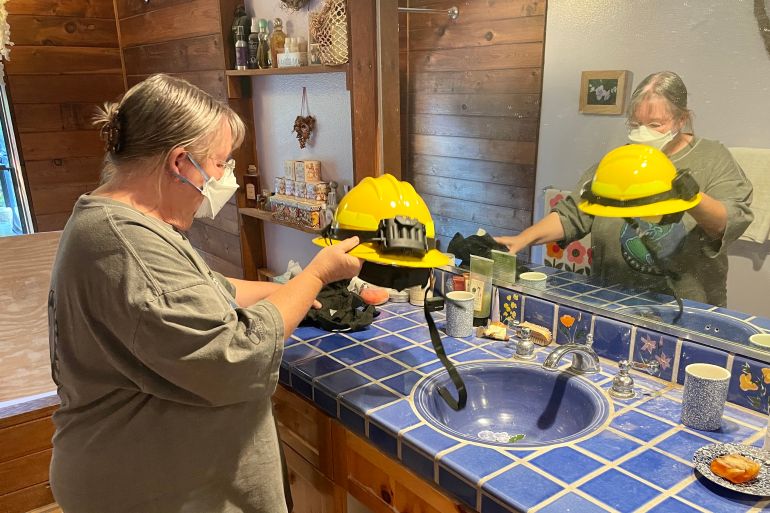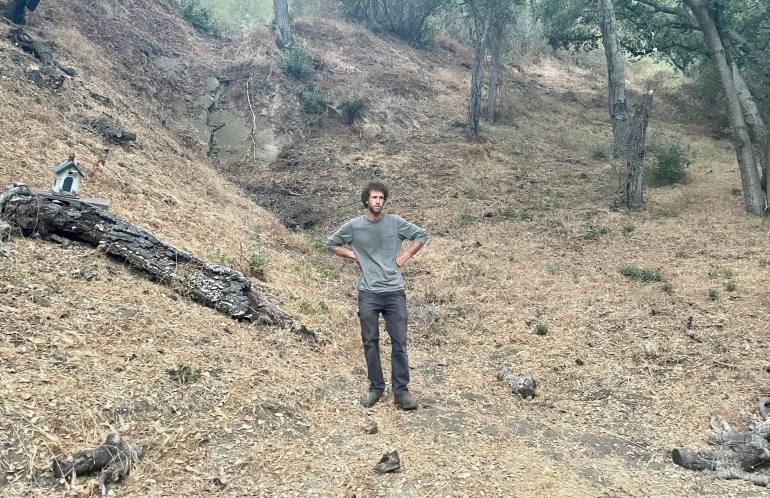How a high-risk California town learned to live with fire
As climate change heightens increasingly severe blazes in US, Topanga has taken steps to reduce its vulnerability.

Topanga, California, US – Leaves crunched under Eli Lichter-Mark’s boots as he walked through his back yard in Topanga in the Santa Monica Mountains, where a drought driven by climate change has siphoned moisture from the oak tree canopy. “You’re here at the crunchiest time,” the beekeeper told Al Jazeera.
A sign on the road leading to his house declares: “Danger – extreme fire hazard area.” A 20-minute drive from the Los Angeles sprawl, the community of about 8,000 people is a tinderbox. Most people live in wooden bungalows, built at a time when the fire risk was lower.
Keep reading
list of 3 itemsUS wildfire dangers seen spreading east as climate risks grow
As US western wildfires ravage property, protection services boom
Three years ago, Lichter-Mark and his wife moved into a home constructed in 1938 with redwood siding, in front of a hill covered in dense brush. “I brought in a group of guys and we probably pulled out six trailers full of brush, sticks, leaves, small trees and branches,” he said.
Fire thrives on wind, steep slopes and dry vegetation and Topanga has all three. In autumn, the Santa Ana winds gust through the mountains, prompting red-flag warnings that indicate extreme risk. The biggest threat to homes is not a wall of flames but high winds that can fling glowing embers kilometres ahead of a fire.
The average number of years between two successive fire events in the Santa Monica Mountains region is 28 years, according to the National Park Service. The last big fire in Topanga was in 1993, meaning it is overdue for the next big one.
There have been a couple of near-misses. In 2018, the Woolsey Fire burned nearly 40,500 hectares [100,000 acres] in the Santa Monica Mountains west of Topanga, killing three people and forcing hundreds of thousands to evacuate. Last year, the Palisades Fire roared through a nearby suburb, forcing hundreds to evacuate, including Topanga residents.
California has more than 75 towns and cities where at least 90 percent of residents live in “very high fire hazard severity zones”, according to a 2019 analysis by the Sacramento Bee newspaper. Topanga is among the 75, with 100 percent of people affected.
Faced with this extreme risk, residents have been adapting: After more than 10 years of organising, the community this year received a Firewise designation from the non-profit National Fire Protection Association, meaning residents have collectively increased the ignition resistance of their homes. Steps towards this goal can include brush removal, landscaping and clearing debris from gutters.
While brush removal is a legal requirement, some Topanga residents have gone further, spending tens of thousands of dollars to resurface their homes and install sprinkler systems – highlighting how communities with more resources are better positioned to protect themselves from the climate crisis.
“Wealthy communities will have an easier time because there’s more disposable income,” Steve Quarles, an expert on fire mitigation and an adviser emeritus with the University of California, told Al Jazeera. “The goal is to do what you can.”
‘It’s only going to get worse’
The 1993 wildfire crawled along the ridge behind Jane Terjung’s home but spared the structure. In 2018, the Woolsey Fire forced her and her husband to evacuate. They have since covered their home’s wood siding in stucco, added ember-proof mesh to vents, installed sprinklers to wet the deck, bought fire-resistant blankets to cover their car and propane tank and purchased a water reservoir. They have also built a “bathroom bunker” where they can shelter in place, complete with a wood panel to cover the window, a hose to put out lingering spot fires, and respirators and helmets.
The adaptations cost more than $50,000, Terjung estimated – but she knows not everyone in the canyon can afford to take these steps. “The census may show a comfortable income, but that’s an average that I believe gets skewed by a small subset of high-earning artists,” she told Al Jazeera.

Ryan Ulyate, the co-president of the Topanga Canyon Fire Safe Council, was also forced to flee his home during the 2018 Woolsey Fire. For those who cannot afford adaptations, the council suggests cheaper options, such as clearing out flammable shrubs or sealing gaps around doors. The California legislature is also considering a bill that would facilitate home adaptation grants up to $10,000 for those in high-risk areas.
“Everybody knows it’s only going to get worse, so the question is, how can we live in these areas that we love?” asked Ulyate.
The council has hosted training sessions and assessed hundreds of homes in Topanga, where the danger is elevated by its location: The canyon has only a few narrow exit roads. Ulyate compared it to Paradise, a town that was destroyed in 2018 by California’s deadliest wildfire on record. Paradise had few roads in or out, making it harder for people to evacuate and for fire crews to enter.
Anticipating this danger, the Topanga fire council has received a grant to remove trees along main access roads to protect evacuation routes, Ulyate said, noting that risk reduction must be a community effort. “The more homes are hardened, the less one home can be a threat to another home,” he told Al Jazeera.
After learning about Firewise two years ago, the council set out to earn the designation, understanding that some companies give discounts on fire insurance to homeowners in Firewise communities. “We thought it was a really good carrot – an incentive to get more people involved,” Ulyate said.

When Lichter-Mark and his wife bought their home three years ago, their private insurance company quoted $10,000 a year based on wildfire risk, which they could not afford. But under a state programme that provides coverage when private insurers will not, they received a 7.5 percent discount for living in a Firewise community.
If a fire threatens Topanga, Lichter-Mark said he wants to stay and defend his home. Rummaging in a closet, he pulled out a portable yellow vinyl bag that held enough water to put out a small fire. “It has a pump, and you can shoot water out,” he said, accidentally spraying his wife, who laughed and shook her head.
“I would hope to be able to stay here,” Lichter-Mark added. “[But] I definitely wouldn’t risk my life to save the house, because my life is irreplaceable and the house can be rebuilt.”